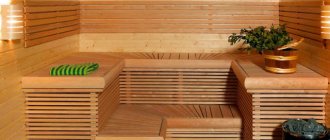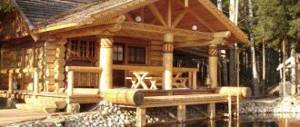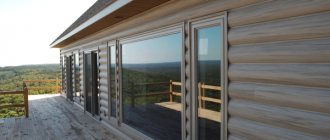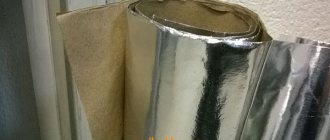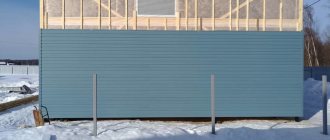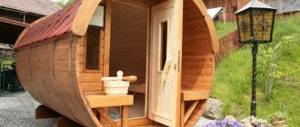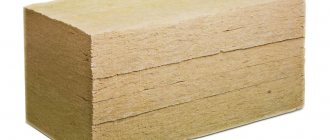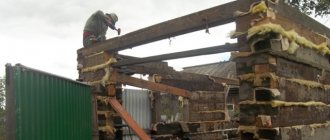Before starting construction of a sauna, it is important to decide on the material, which is better for a bath, linden or aspen, choose alder or cedar. There are many options for wood for walls and decoration, and they are all interesting and attractive in their own way. Each type of wood has its own advantages and disadvantages, so using only one type, for example, cedar for a bathhouse, will not be entirely correct. Even if it seems that facing the walls with steamed aspen is no better than finishing with cedar.
How to compare materials correctly
Of course, there are financial resources and time, quite realistically, and universal solutions. For example, build a log bathhouse from cedar, preferably Canadian, and use African oak to decorate the steam room. Even with a successful design, steaming in such a bathhouse is not much better or more comfortable than in a regular one, but it will last ten times longer than a log house made of aspen or even larch. But such a box will be very expensive. Perhaps, with the money spent on arranging such a bathhouse, it would be better to build four full-fledged wooden saunas made of cedar pine and linden.
Wood used in bath construction is divided into three categories:
- Finishing material for steam room walls, shelves, bath accessories;
- Material for arranging the wettest parts of the bathhouse;
- Wall block or timber.
This division did not arise by chance; as a rule, a certain type of wood performs best under certain conditions. For example, oak or larch are better suited than pine or alder for a bathhouse when it comes to constructing a log house or building frame. At the same time, heavy oak, acacia or birch are never used for wall decoration of the steam room. The denser the wood, the more it burns the skin, and birch board also produces bitterness.
What is better to pay attention to
When choosing a material, in addition to price and tactile perception of the wood surface when touched, you need to pay attention to two important points:
- Wood workability;
- Resistance of the material to moisture and high temperature;
- Decorative qualities and smell.
All three categories have their leaders and outsiders. For example, linden and aspen have the best workability, cedar and larch are considered to be moisture-resistant, alder and abash are considered the most beautiful and comfortable to touch.
Of course, there are universal types of wood, the qualities of which are no better than those of the leaders, but they can be used to a certain extent for any parts of the bathhouse. Such materials include aspen, larch and cedar.
Aspen bathhouse, pros and cons
At first glance, aspen is no better than cedar or beautiful alder. You can understand the choice at least by the fact that in the old days most of the log baths were built from specially selected aspen logs. In modern comfortable steam rooms, aspen is used in places where it would be better to lay plastic or expensive mahogany.
At the same time, according to reviews, a log house made of aspen for a bathhouse could withstand, without any treatment, in damp, swampy areas where only larch and oak can withstand.
For your information! Aspen is a capricious material that requires a special approach and attention. Especially when harvesting logs and preparing them for placement in a bathhouse box.
But with the right approach to the material, in the hands of an experienced craftsman, it is difficult to find better aspen for building a bathhouse.
Construction of a log bathhouse
If you decide to use larch to build a bathhouse, then there is no point in looking for other materials for the foundation. Larch is an ideal wood for floor joists and foundation construction.
Step-by-step instruction
- Waterproofing material should be laid on the foundation. Inexpensive roofing material is perfect for this purpose.
- The first crown - the frame - is laid on the foundation. It should be slightly wider than the other logs. The voids between the foundation and the flashing can be filled with rubble and sealed with mortar or polyurethane foam.
- The most aesthetic method of laying crowns is the classic, ancient “butt-top” method. This method will give you the opportunity to maintain a horizontal level, and it looks extremely beautiful.
- In the old days, a layer of moss was placed between the crowns. Nowadays, you can use jute, tow, insulating material or the so-called. "construction" moss. This natural material does not rot or dry out.
- You can give the end connecting notches any shape, for example, “into a paw”, “into a head”, “into a bowl”. The logs are fastened together with dowels. Having laid 3-4 crowns, the wood can be treated with waterproof mastic and tinted.
- You should not fasten the two upper crowns - after the frame shrinks, they are removed and the ceiling beams are fixed.
- Before the roof is installed, the log house needs to be stabilized. This process takes several months or more - depending on the climate and time of construction of the log house.
- After the logs have settled, you can install and arrange the roof with any material of your choice - slate, bitumen or ceramic tiles, etc.
- It would be logical to use the same larch for interior decoration - both from an aesthetic and practical point of view.
How is aspen better than other species in a bathhouse?
The tree grows on waterlogged soil, so the structure of the material is thin intertwined fibers, quite dense and viscous. To build a log bathhouse, they use trunks of forty-year-old trees, carefully selected and discarded. After winter drying, the logs are sawn and assembled into a log house, and it is best to build quickly, joining the crowns at the corners “into a paw.” Very quickly, an aspen log house for a bathhouse shrinks, the aspen wood becomes very compacted and hardens, and cutting it becomes very difficult.
The advantages of aspen include the following qualities:
- Fresh and dried wood is quite soft and pliable due to high humidity. In this state, aspen, like linden, can be cut with a knife in any direction of the grain;
- Aspen is not afraid of heat shock, high temperature, and humidity. Wood is better perceived when touched by hand than any other material, the only exceptions being mahogany or African oak;
- Properly dried, treated and aged wood is not afraid of putrefactive bacteria, fungus and even some wood insects.
For your information! At the same time, aspen has quite high strength; joists, ceilings, frames of door and window openings are made from boards and timber.
Often, an aspen log house is not even lined with additional finishing from the inside. Moreover, the craftsmen claim that it is better to leave the aspen crowns as they are, open. It is believed that steamed aspen releases special substances that are good for toning the breath and skin. The popularity of aspen baths is so great that some extraordinary medicinal properties are attributed to its effects, despite the fact that aspen wood does not have any phytoncides or resins, like conifers.
Columnar foundation: main stages of construction
Before burying wooden supports in the ground, it is necessary to ensure waterproofing of that part of the pillar that will go underground. To do this, it is impregnated with an oily solution and wrapped with roofing felt or roofing felt, gluing the waterproofing layers with bitumen mastics. This will protect the surface of the post from contact with the soil and reduce the likelihood of rotting and freezing to the ground. The use of a waterproofing stocking minimizes the impact of frost heaving forces on the pole.
Wooden columnar foundation: a – bed; b – piles.
The wooden support is installed in a dug hole, aligned in a vertical position. Wooden posts are placed along the walls, and they must be installed exactly along the axes of the walls. To do this, lighthouse poles are installed in the corners of the future house and at the intersections of walls, into which nails are then driven and a cord (nylon thread, wire or fishing line) is pulled tightly. After this, they begin to install the intermediate supports, checking the vertical position along the plumb line, and the horizontal position along the mooring (cord).
For greater stability and increasing the load-bearing area of the support, the lower part of the larch chair must be installed on a wooden cross with struts (for non-buried foundations) or a concrete slab (for buried foundations). To make a cross, take 2 wooden blocks up to 70 cm long, fastened together crosswise. The support chair is usually secured to the cross using metal brackets. For greater stability, a spike is cut out in the lower part of the log, and a nest is made in the upper beam of the cross. This simple design allows you to increase the supporting area of wooden chairs, making the columnar foundation resistant to the forces of frost heaving.
To increase the reliability of buried wooden foundations, a cushion is made of monolithic concrete. A layer of concrete 20 cm thick is poured onto the bottom of the sand cushion and, without allowing it to harden, the pillar is immersed to a depth of 10-11 cm. After the concrete has hardened, the wooden chair is rigidly fixed.
What is inconvenient about aspen for arranging a bathhouse?
The main disadvantage of aspen wood is the difficulty in selecting quality material. Aspen, like no other material, must be carefully selected and discarded. The better the screening, the longer the bath lasts. If you come across a log with foulbrood, it can infect the entire structure before the aspen becomes dense and insensitive to rot.
The second disadvantage is considered to be the darkening of the surface under the influence of air and sunlight. To return an aspen bathhouse to its original light appearance, it is best to sand the surface or sandblast it.
Sauna made of aspen and linden
Both materials are considered the most affordable and in demand for interior decoration of saunas, steam rooms and even dressing rooms. Shelves and benches are most often made from linden, since in a hot steam room a soft linden bench always feels cooler to the touch than aspen. Especially after several years of service in a humid environment.
How to distinguish linden from aspen. The question is simple, but important when it is necessary not to confuse the material used for lining the steam room and for the door blocks in the bathhouse. Freshly planed slats and boards made of linden and aspen are practically indistinguishable in color and texture. Aspen has a more pronounced fiber pattern and a slightly lighter, even grayish surface tone.
Linden can be distinguished by its characteristic smell; sometimes craftsmen check the maturity and dryness of the material with a drop of honey. On aspen it will spread and be absorbed, but on linden it will remain a compact droplet. Of course, linden is only suitable for cladding and furniture of a steam room; it makes no sense to build a log house or a bathhouse frame from it.
Sometimes bathhouse customers wonder what is better, aspen or linden in the steam room. Both materials are almost equivalent, both darken over time from water and dirt. Only linden absorbs everything that is washed off, while aspen simply oxidizes and becomes stained. In both cases, texture and color can be restored.
If you have to choose between linden and aspen, it is better to remember the unique properties of aspen wood to kill pathogens. In the old days, it was used to make upholstery and tubs for drinking water, which never became cloudy and bloomed.
Comparison of larch with wood-polymer composite (WPC)
First of all, natural, “living” wood cannot be replaced by any artificial material.
Today, such material as decking made of WPC (wood-polymer composite) is actively advertised, but during operation a number of side effects almost immediately appear:
— the acrid smell of plastic that comes from the WPC when the temperature rises, and the bathhouse is a place where high temperatures cannot be avoided;
— in conditions of high humidity, mold and mildew may appear on WPC decking;
- due to temperature changes and waterlogging, the WPC is deformed.
In short, a WPC decking board in a bathhouse is unlikely to last long and will not benefit your health. You can find out a more detailed comparison here
Alder sauna
The very beautiful and unusual texture can vary from pinkish-yellow to rich, almost orange colors and shades. Alder, along with linden and aspen, is one of the three materials most often used for finishing a steam room in a bathhouse. According to reviews, alder for a bath remains a rather complex material:
- The strength of the wood is low, but there are no cracks or chips in the finishing of the bathhouse;
- It easily absorbs water, but when stained for a long time in water, it simply acquires metallic strength, like stained oak;
- It does not tolerate overheating well, but the smell of a smoldering splinter or heated wood is considered very pleasant, even refined.
Freshly cut alder is almost white, like poplar or aspen. After drying in air, the surface becomes orange-red; after treatment with an ammonia solution, it acquires a very beautiful texture and color. Alder veneer is used in bathhouses as a way to imitate mahogany. In decorative terms, a properly processed alder surface looks better than natural mahogany, chestnut or walnut.
If you need to provide a pronounced therapeutic effect, then black alder is better suited for a bath. It, like aspen, releases a huge amount of volatile substances that have a beneficial effect on the upper respiratory tract.
Larch bathhouse
All coniferous wood species are considered to be the most suitable for the construction of walls, ceilings and floors. A larch bathhouse can be easily distinguished from a pine or cedar structure by the darker color of the wood. The cedar bathhouse photo looks light, with a yellowish tint.
Larch wood is known for its incredible resistance to decay and mold pathogens. Boards and slats can easily withstand alternating loads at high temperatures and in conditions of high humidity, so a log bathhouse made of larch turns out to be the most durable and strong of all conifers.
The construction of a bathhouse from larch, without any additional processing, has the durability and strength of modified stained aspen. Larch is best suited for sheathing insulation, joists, ceilings, wherever elements of the bath structure come into contact with moist hot steam.
The only thing in which larch loses to aspen is its tendency to form cracks, chips, and chips; when heated strongly, a resin is released that can stick to it. Therefore, it is not used on the floors and furniture of steam rooms. Larch cladding has a resinous, tart odor that never goes away, even after several years of service.
Most modern projects are bathhouses in the form of a log house made of cedar. Relatively inexpensive and accessible Siberian pine wood is considered the optimal material in terms of price and quality of construction. Unlike aspen or larch, cedar is cheaper and better processed by machine, so it has become the most popular material for baths.
The material has a large amount of resin with a pleasant smell, which is not irritating and can cause allergies. Therefore, it is best to use cedar that has been bleached with hydrogen peroxide for a steam room. A cedar steam room is inferior to an aspen room in terms of durability and rich atmosphere.
Digging holes and creating a sand cushion
To install larch posts, you need to dig holes with a diameter of at least 35 cm, i.e. 1.5 times the diameter of the logs. If the diameter of the support is 30 cm, you need to dig a hole with a diameter of 45 cm. Holes can be dug in several ways. The manual method involves digging a hole with your own hands using a shovel. This method does not require costs, but is very labor-intensive. The mechanized method using special equipment will require additional costs, but will save your time and effort. A layer of sand 10-20 cm thick is poured into the bottom of the prepared pits, followed by compaction.
